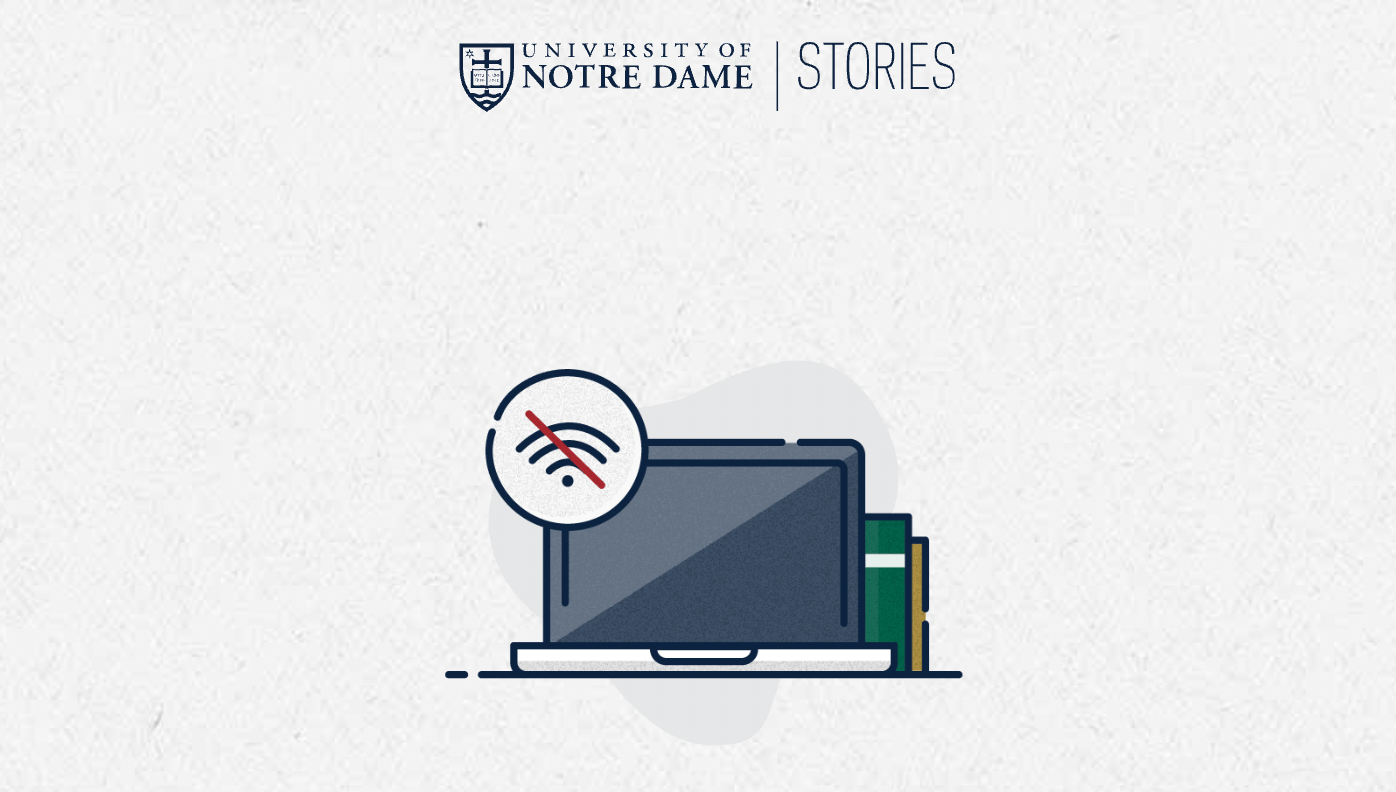August 15, 2022
By Brendan O'Shaughnessy
R.J. Thrist, a second-grader in South Bend, likes to go online to watch cartoons or NFL football, but he also uses his school-provided Chromebook to log in to assignments his teacher posts, listen to books read aloud, play math games and turn in homework projects.
The challenge for his mother, Tabitha Williams, is paying the fees for that online connection. Even a program to provide internet access for $10 a month could be too much when she sometimes had to choose between paying for basics: food, gas, medicine and utilities.
Williams, 43, who is on disability after badly injuring her arm at work, recently moved in with her brother because her rent was too high. She was thrilled when Citywide Classroom South Bend gave R.J. a hotspot device that can be used for internet access.
“It’s been amazing,” she said. “It’s so helpful and I’m so thankful for a program during this time that’s so hard. It’s something we rely on day to day.”
Williams and her son face a situation common to up to 30 percent of South Bend public school students who lack a reliable internet connection in a world that progressively requires that access for daily activities — from schoolwork to ordering food to job applications.
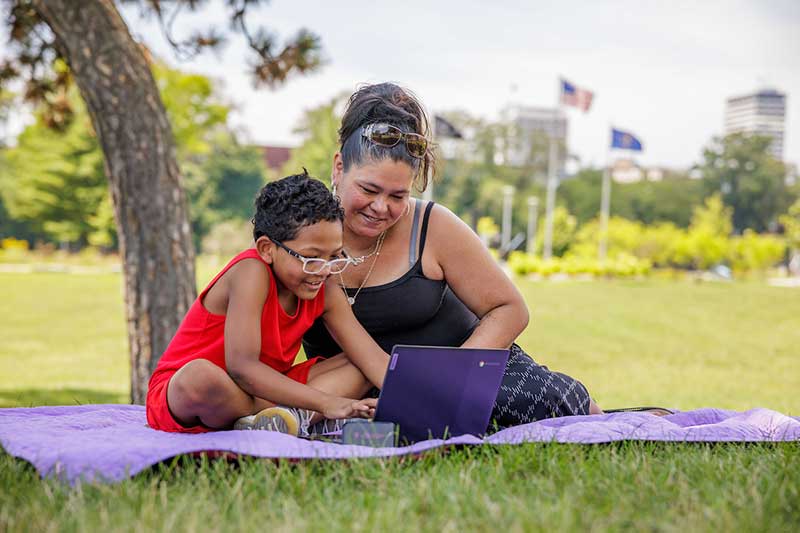
Several years ago, South Bend public schools recognized that they needed high-tech solutions to bridge this digital divide. They turned to enFocus, a nonprofit organization and regional resource for talent attraction that grew out of Notre Dame’s Engineering, Science and Technology Entrepreneurship Excellence Master’s (ESTEEM) program.
Now celebrating 10 years of regional development projects, enFocus partnered with the schools and the city to create Citywide Classroom South Bend (CCSB), which has delivered multiple solutions to bring students online access. It’s perhaps the most ambitious of more than 450 enFocus projects bringing talent, innovation and entrepreneurship to business, school, city and nonprofit partners in the region over the last decade.
First, CCSB helped to deploy school buses equipped with Wi-Fi equipment across the city during the pandemic. Then it worked with the city and local partners to provide thousands of hotspot devices that allow students to get online nearly anywhere. The hotspots were especially helpful for students like R.J., who alternates weeks living with his mother and father.
Starting this new school year, CCSB partnered with Notre Dame’s Wireless Institute and Office of Information Technologies to pioneer its own private LTE network with a pilot project that will broadcast access from three towers that can reach 1,000 families. The ultimate goal is a private broadband network that enables access for all South Bend public school students.
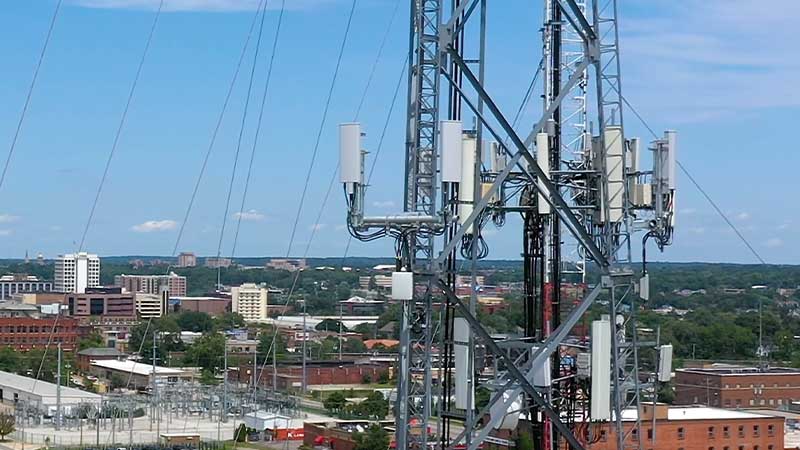
“You can give anyone a Chromebook, but if you can’t connect to the internet, it might as well be a clipboard,” said John Anella, chairman of the South Bend Schools Board of Trustees.
Project Manager
Building a private LTE network is an ambitious goal, and it’s being run by a 24-year-old Notre Dame graduate who fell in love with South Bend through his involvement in enFocus.
Patrick McGuire served as vice president of the student body and graduated in 2021 with a degree in economics and sociology. His mother and three older siblings preceded him at Notre Dame, which served as a substitute home base because the military family moved often.
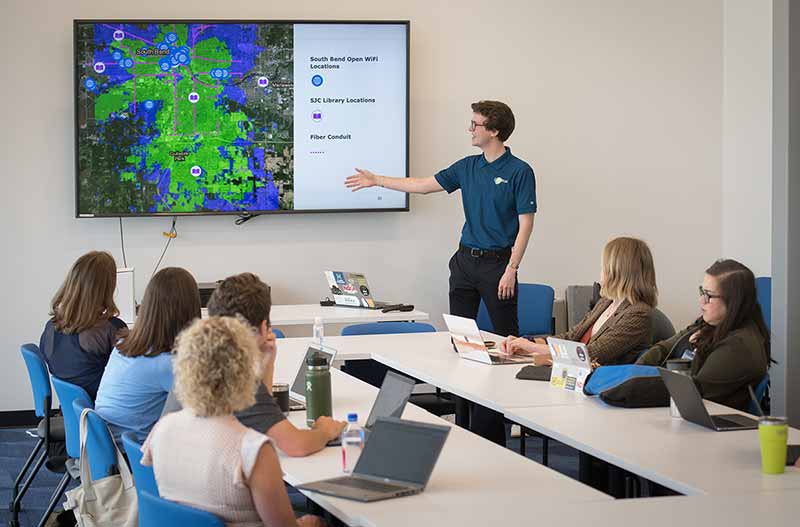
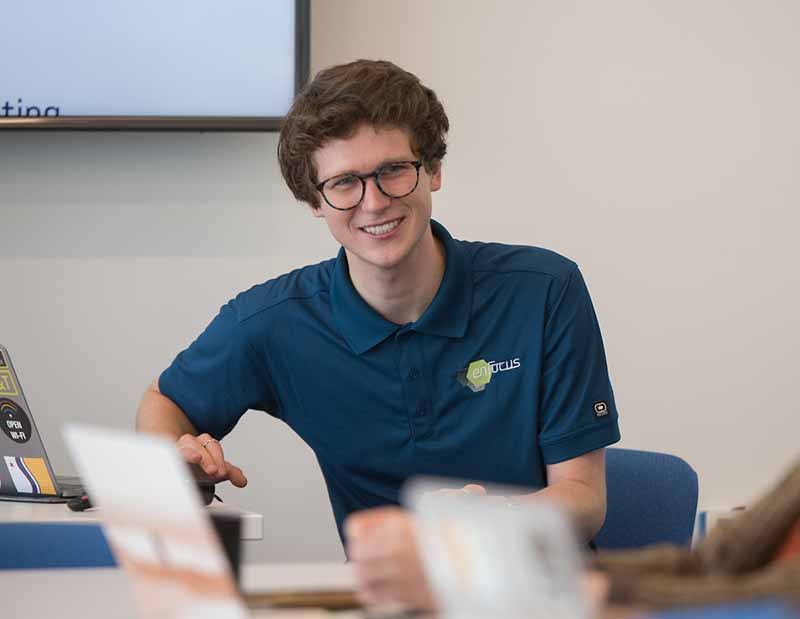
But he said he knew little about South Bend until he came to school and interned for former Sen. Joe Donnelly. That experience led him to intern at enFocus, which left him impressed both with the region and the opportunity to do important projects at a young age. He knew he wanted to continue on to the fellowship program after graduation.
“I wear many hats, mostly revolving around digital equity in South Bend,” McGuire said. “For the private LTE network, I’m the project manager. That means bringing together all the partners in this coalition — coordinating between the city, schools, enFocus, Notre Dame. Coordinating the vendor selection process, the network design, the legal review process — kind of a Swiss Army knife for the project.”
When he started, he didn’t know what an LTE network was. Now, he explains it as the type of internet connection mobile phones used after 4G but before 5G. In 2017, the federal government designated a chunk of the electromagnetic spectrum that it regulates as public access airwaves, called the Citizens Broadband Radio Service (CBRS). Using CBRS, anyone with a license and the right equipment can broadcast an LTE signal.
“This is where it gets really over my head, so we lean heavily on our partners at Notre Dame,” he said. “They really understand this technology. They were critical in helping us discover a solution and making it happen.”
Nick Laneman, co-director of the Notre Dame Wireless Institute, said it’s exciting to take part in a collaborative effort to improve online access, which became even more important when the pandemic kept everyone home.
“It could be risky for the city or school district to take on this new and complicated technology,” he said. “We are trying to reduce that risk. We hope to keep the network up and running without requiring students or parents to be IT experts.”
A pilot project will begin this school year with LTE equipment broadcasting from towers at Riley High School, Jackson Elementary and Hayes Tower in Ignition Park. It will provide access to about 1,000 families close enough to get the signal. Because public school families average three kids, the signals could reach as many as 3,000 students.
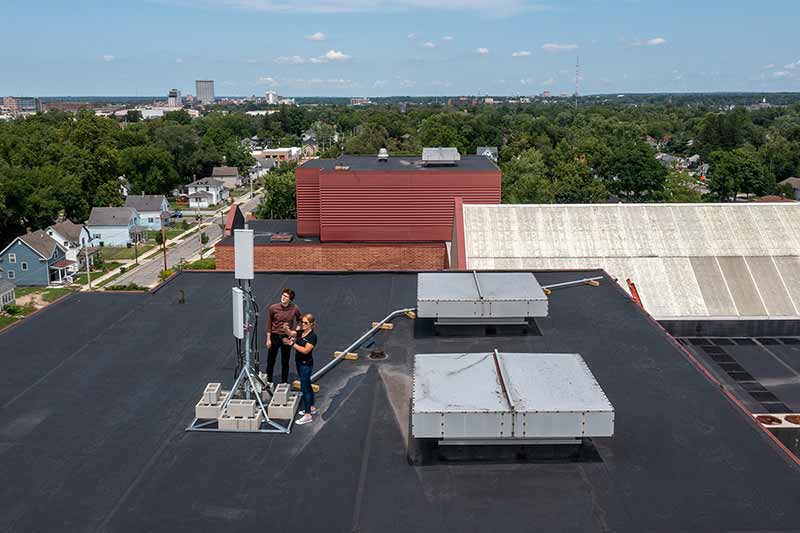
“We see the private LTE network as the quickest way to connect the hardest-to-reach families now,” McGuire said. “Based on the pilot, we can see how feasible it would be to connect every family in the school district that lacks internet. Potentially with a 16-tower network, we could provide this network to every student in need.”
Laneman said the partnership benefits the city, local students and families, and Notre Dame too. “The is a technology and a way of using radio spectrum that we are interested in for our teaching and research in the future,” he said.
Multiple Layers
While the LTE pilot project is the shiny new toy, it’s only the latest in a series of connectivity efforts that enFocus has led in South Bend.
“Since the inception of enFocus, there has been a large emphasis and partnership surrounding the digital divide,” McGuire said. “It’s a constantly evolving suite of projects.”
“We’ve focused on students because of the e-learning emergency, but we also want to help other vulnerable groups.”—Denise Linn Riedl
It began in 2015 with the coalition that started the South Bend Open Wi-Fi network the following year. The SBOurGuest public network provides free access from more than 50 locations downtown and has expanded continually.
Denise Linn Riedl, the city’s chief innovation officer, said historical segregation shaped infrastructure development in most cities, South Bend included. Those inequities are perpetuated if the free market determines internet access, she said.
“We’re attempting to change that,” Riedl said. “We’ve focused on students because of the e-learning emergency, but we also want to help other vulnerable groups.”
Patrick Stalvey, chief information officer for the South Bend Community School Corp., said he has worked with enFocus since 2016, when students were sharing 13-year-old computers. EnFocus worked with the schools to digitize millions of HR records, and helped with the transition to individual Chromebook distribution.
Just before the pandemic, in January 2020, the school district had already started a pilot program to equip 20 school buses with free Wi-Fi so that students could do homework during their commute. When COVID-19 shut down the schools, enFocus worked with the schools to map out where to park the buses to provide reliable connections for students in need.
The district was awarded a $1.8 million grant in 2020 through the Governor’s Emergency Education Relief Fund, part of the pandemic relief efforts. That funding allowed the creation of Citywide Classroom South Bend, which expanded the bus program to 35 buses the next year.
“We caught national attention with the bus program,” Stalvey said. “It wasn’t totally unique but it wasn’t widespread either. We worked with enFocus to write that grant.”
CCSB also began programs to give out access hotspots or Comcast subscriptions. Stalvey said the partners learned that many families didn’t trust the commercial providers because they had past bad experiences with rising costs or bill collections. The new programs reached about 4,500 students, but the LTE network provides more opportunities and a multilayered approach.
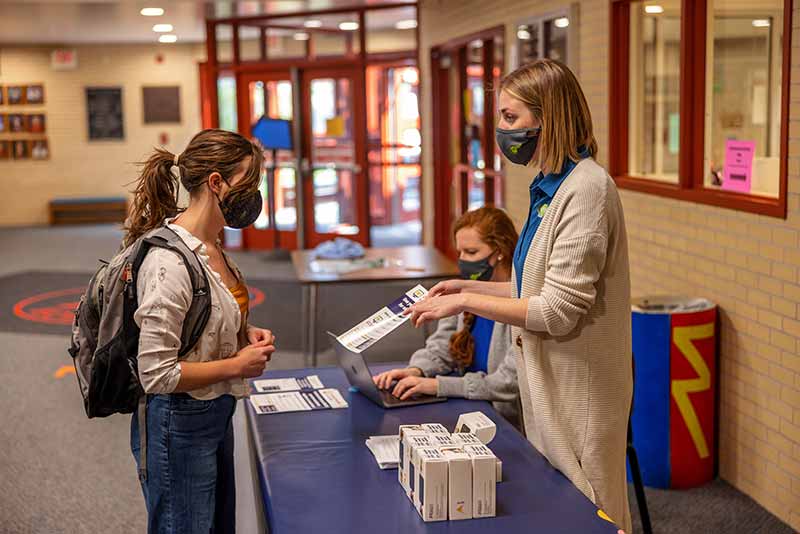
“The best case is that we secure funding to make it citywide,” Stalvey said. “There is a bigger capital outlay, but we can use the grants to build it out. Then it will reduce our operating expenses significantly in the future.”
Stalvey said the “unmatched talent” and outside viewpoint that enFocus provides for a low cost has been key to getting these projects off the ground. He has also hired several enFocus alumni.
CCSB’s success has inspired nearby cities like Mishawaka and Elkhart to emulate its online access efforts. Emma Sedlack, a Notre Dame student interning at enFocus this summer, said she worked with CCSB to broaden its reach by changing the name to Citywide Classroom and rebranding with a new logo — so that it’s not limited to South Bend.
“We worked through how to distribute hotspots in Mishawaka,” Sedlack said. “We want to make sure families understand how the program works so they will trust it. Lots of students in Mishawaka need connectivity, so it was a good first step.”
enFocus Growth
The fellowship program has come a long way since its 2012 inception. That spring, the director of the ESTEEM program, David Murphy, took a few dozen aspiring entrepreneurs to South Bend’s Union Station, which houses computer servers and high-tech businesses.
A few weeks later, the same graduate students took a spring break trip to North Carolina’s Research Triangle. In Durham, they marveled at a buzzing startup incubator called American Underground, located in a former Lucky Strike cigarette factory that had been transformed into a mixed-use development of restaurants, entertainment venues, housing and green space.
“Our mission to empower talent to build better communities attracts talented professionals from across the world to our region.”—Andrew Wiand
South Bend native Andrew Wiand and six peers believed they could emulate that budding potential to solve community challenges in South Bend. They pitched the idea of a talent incubator to local business leaders and partners at Notre Dame, envisioning a one-year fellowship working on high-tech projects with local businesses and organizations that would attract talent and fight brain drain in the area.
Each enFocus fellow leads a project, with a local business leader as a mentor. The community in turn reaps the benefit of talented and motivated consultants at an exceptionally low price.
Wiand, now the enFocus executive director, spoke at a July celebration of the group’s 10th anniversary and recalled a similar gathering in 2012 where he introduced himself to the first person he met.
“I said, ‘Hi, I’m Andrew, an enFocus fellow, and I’m working in health care,” Wiand said. “And he said, ‘Hi, I’m the CEO of health care locally.”
From that embarrassing start, Wiand ticked off how much has been accomplished since: hundreds of projects with 150 regional partners, more than 1,000 student interns and 150 fellows. The program has grown from seven to 32 fellows this year supported by five full-time staff with a footprint across Northern Indiana. It has supported 43 startups and 65 social impact initiatives and has helped generate more than $6 million in grants for partners.
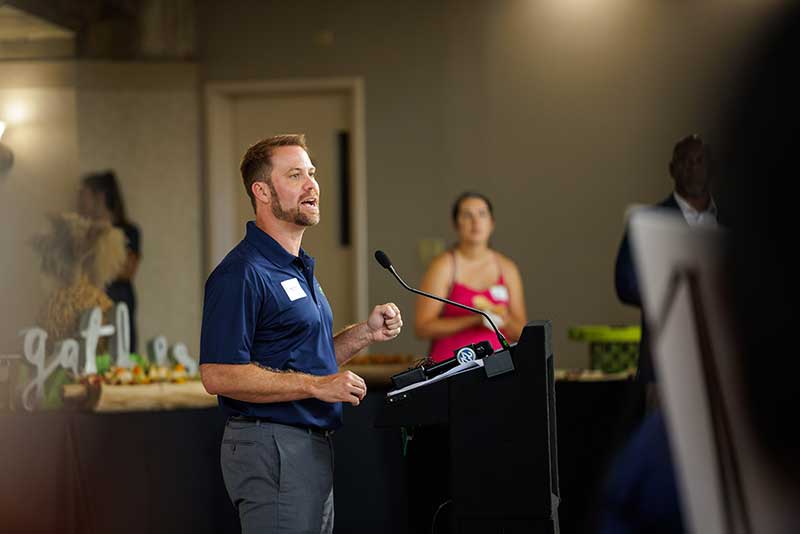
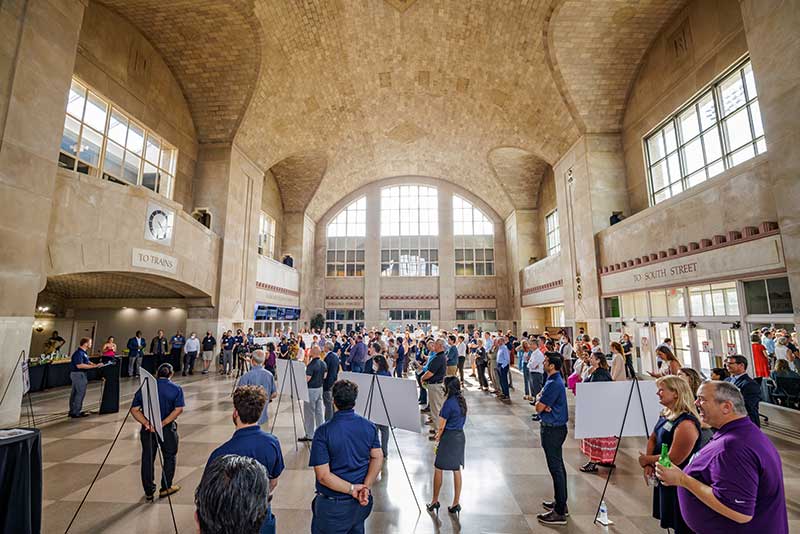
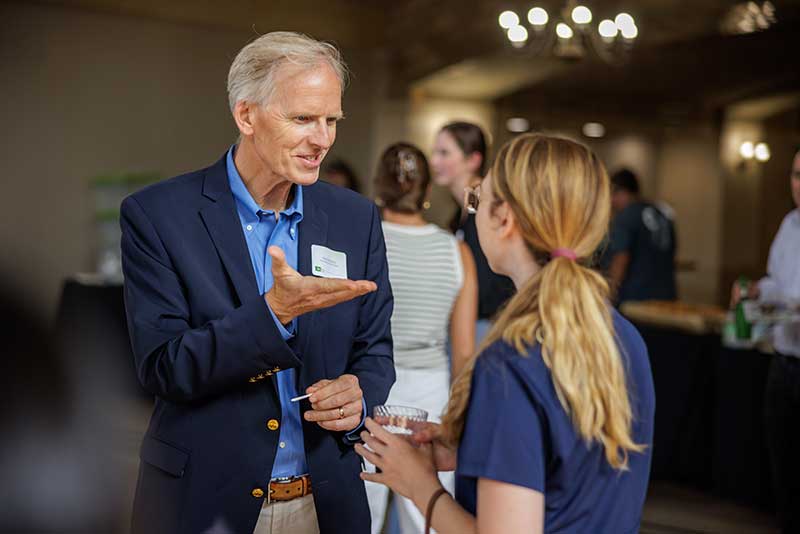
An early project, for example, increased the use of sport utility vehicles rather than fire engines to respond to non-emergency medical situations, saving $1 million in vehicle costs over five years. More recent partnerships with manufacturers connected to iNDustry Labs at Notre Dame have unlocked millions of dollars in value through process improvements, automation technologies and enhanced business planning.
Fellows now join for two years, and maybe most impressively, about 70 percent of them stay in the region after they finish. The program, now located in a former Studebaker building with an office in Elkhart, has spread its wings beyond ESTEEM and aims to become a national model. That starts with a new office in southwest Michigan next year.
“Our mission to empower talent to build better communities attracts talented professionals from across the world to our region,” Wiand said. “We think our secret sauce has been to work with organizations who expose challenges and ask how we can help.”

For R.J. Thrist and Tabitha Williams, that challenge was online access. Their favorite place to visit in South Bend is Howard Park, where a new skating ribbon and playground were built during the pandemic. Williams said they never go anywhere without their CCSB hotspot.
On a recent summer day, R.J. used it to play a video game. But once Lincoln Elementary is in session, his mother reminded him, he has to do his homework online before he gets to romp through the playground. “Definitely,” she said, “it’s a huge help.”
Produced by the Office of Public Affairs and Communications at The University of Notre Dame
Writer: Brendan O’Shaughnessy
Photography: Matt Cashore, Peter Ringenberg, Steve Toepp
